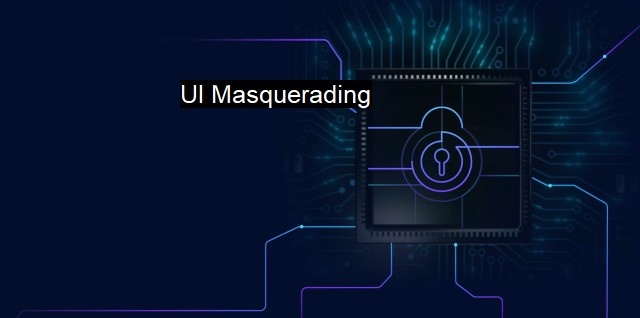What is UI Masquerading?
Protecting User Interface (UI) from Cyber Attacks: Understanding UI Masquerading and the Impact on User Experience
UI Masquerading is one of the increasingly prevalent forms of malicious tactics employed by cybercriminals in the realm of cybersecurity. UI stands for User Interface, which refers to the part of a software application that users interact with. It comprises the screen layout, buttons, dialogue boxes, menus, and everything else users engage with while interacting with an app or website. Masquerading, in this context, implies pretending or impersonating.Thus, UI Masquerading as a term refers to a nefarious practice where bad actors create deceptive, fake user interfaces extremely similar to authentic applications. The purpose of UI Masquerading is to fool unsuspecting users into thinking they are interacting with a genuine interface. In turn, it leads to a deceptive interaction, with users inadvertently surrendering sensitive personal or professional data to threat actors.
UI Masquerading applies to any GUI (Graphical User Interface) based software, including web browsers, standalone applications and system dialogs. It's a common tactic used in phishing attacks, where an email or a webpage impersonates a well-known business or brand, luring victims into providing personal information or clicking on a malicious link.
The quintessential example of UI Masquerading is a fake login page; these pages are ordinarily designed to look exactly like genuine login pages, down to the last detail. If an unsuspecting user enters their credentials into this fake page, the fraudsters can collect the data and use it to access the user's account.
In antivirus terms, UI Masquerading can also refer to malware that impersonates legitimate antivirus software. The masquerading UI convinces users that they are interacting with the real antivirus product, and the result often lures the user into performing an action (like paying for a fake license or downloading additional malware) that benefits the attacker.
UI Masquerading is a very serious cyber threat because of its ability to seamlessly blend in with valid UIs. It uses the everyday interaction between the user and the regular software applications they utilize, hence why it becomes so deceiving. With the increasing sophistication of hacking tools, the graphical interfaces of native applications can be replicated to a very high degree, making the identification of UI Masquerading attacks extremely challenging for both the users and security systems in place.
The potential damage from UI Masquerading attacks can be enormous. Depending on what information the misrepresented UI collects, users can fall victim to outcomes ranging from identity theft to financial losses. these types of attacks can significantly erode trust in digital systems, as users frequently input sensitive and essential data based purely on faith.
One effective way of protecting oneself from falling victim to UI Masquerading is user vigilance and a strong grounding in cybersecurity best practices. This could be in the form of questioning any unexpected prompts that seem out of place or verifying the web address before entering sensitive information. Technologies also exist that warn users when they're about to enter their credentials into unsecured forms.
Countermeasures against UI Masquerading involve standard antivirus software, firewalls, regular system patches, and updates alongside user education in identifying suspicious interfaces. Equally, corporations must ensure their cybersecurity defenses are up-to-date and consider employing technologies that focus on identifying altered integrity at the UI layer.
UI Masquerading poses a significant risk in the world of cybersecurity. It's a malicious tactic that exploits the user's trust in familiar applications by impersonating them, thereby enabling cybercriminals to steal sensitive data. Therefore, there remains the need for both users and businesses to remain informed about potential threats of this nature and construct a robust defense system against them.

UI Masquerading FAQs
What is UI masquerading?
UI masquerading refers to a type of cyber attack where a malicious software or application disguises its user interface (UI) to appear as a legitimate program or system process.How does UI masquerading work?
In UI masquerading attacks, the attackers create a fake UI that looks identical to the UI of a legitimate software. This UI is then used to trick users into providing sensitive information or download malware onto their system.What are the risks associated with UI masquerading attacks?
UI masquerading attacks can lead to significant risks for individuals and organizations, including identity theft, financial loss, and data breaches. These attacks can also compromise the security of a system and allow hackers to gain unauthorized access or control over a device or network.How can I protect myself against UI masquerading attacks?
To protect against UI masquerading attacks, it is important to exercise caution when downloading and installing software, especially from unknown sources. Users should also pay close attention to the UI of the applications they use and look out for any anomalies or discrepancies. Lastly, using reputable antivirus and anti-malware software can help detect and prevent UI masquerading attacks.| | A | | | B | | | C | | | D | | | E | | | F | | | G | | | H | | | I | | | J | | | K | | | L | | | M | |
| | N | | | O | | | P | | | Q | | | R | | | S | | | T | | | U | | | V | | | W | | | X | | | Y | | | Z | |
| | 1 | | | 2 | | | 3 | | | 4 | | | 7 | | | 8 | | |||||||